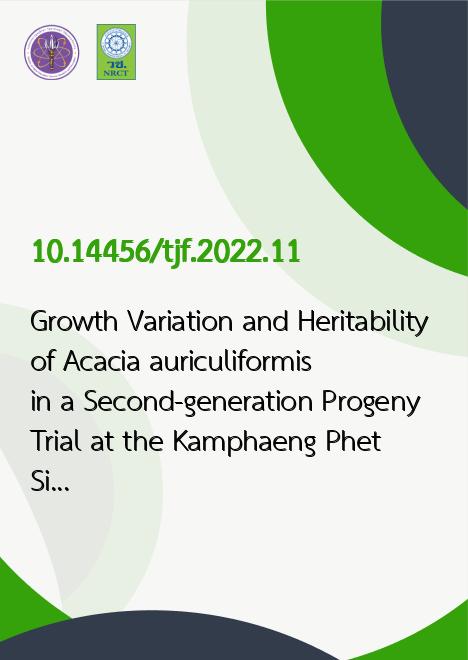
|
Growth Variation and Heritability of Acacia auriculiformis in a Second-generation Progeny Trial at the Kamphaeng Phet Silvicultural Research Station, Kamphaeng Phet Provincein a Second-generation Progeny Trial at the Kamphaeng Phet Silvicultural Research |
|---|---|
| รหัสดีโอไอ | |
| Creator | Kittiporn Suwannapong |
| Title | Growth Variation and Heritability of Acacia auriculiformis in a Second-generation Progeny Trial at the Kamphaeng Phet Silvicultural Research Station, Kamphaeng Phet Provincein a Second-generation Progeny Trial at the Kamphaeng Phet Silvicultural Research Station, Kamphaeng Phet Province |
| Contributor | Somporn Maelim, Chakrit Na Takuathung, Prapai Kaennak |
| Publisher | Kasetsart University |
| Publication Year | 2565 |
| Journal Title | Thai Journal of Forestry |
| Journal Vol. | 41 |
| Journal No. | 2 |
| Page no. | 136-146 |
| Keyword | Growth, Acacia auriculiformis A.Cunn. ex Benth, Progeny test, Heritability |
| URL Website | https://li01.tci-thaijo.org/index.php/tjf/issue/view/17492 |
| Website title | Thai Journal of Forestry |
| ISSN | 2730-2180 |
| Abstract | The aims of this study were to investigate the variations in growth, shape, survival, and heritability (h2) of Acacia auriculiformis in a second - generation progeny trial at the Kamphaeng Phet Silvicultural Research Station, Kamphaeng Phet province in trees between the ages of 1-6 years old, by using a randomized complete block design (RCBD) trial with 20 replications. The diameter at breast height (DBH) and height (H) of all trees in the families belonging to three provenances (Papua New Guinea (PNG) Northern Territory (NT), Australia Queensland (QLD), Australia) were measured each year until the age of 6 years. Additionally, the axis persistence and stem straightness at age of 6 years was also evaluated. The 10 best families were selected using the growth and shape as indicators. All the characteristics were analyzed using analysis of variance (ANOVA) method in the R program. The results of the study indicated that Acacia auriculiformis of age 6 years had an average survival rate of 61.32ฑ7.29 %, with a DBH of 12.65ฑ0.86 cm, and an average height of 12.83ฑ0.65 m. Most acacia trees had stems that was slightly bent and there a slight branching was seen at the bottom of the tree. The results showed that there were highly significant differences in DBH and H of trees between the ages of 1-3 years and significant differences were obtained at the age of 6 years (p<0.01). The heritability (h2) for age 6-year-old trees was found to be in the moderate to high range (0.2 - 0.4). This shows that all the characteristics of such acacia trees are influenced by genetics. The family that had the highest ranking was family 10 followed by family 20 (QLD), family 15 (PNG), family 36 (NT)), family 18 (PNG), and family 23 (QLD), respectively. As such, these species can be promoted for use to the farmers. |